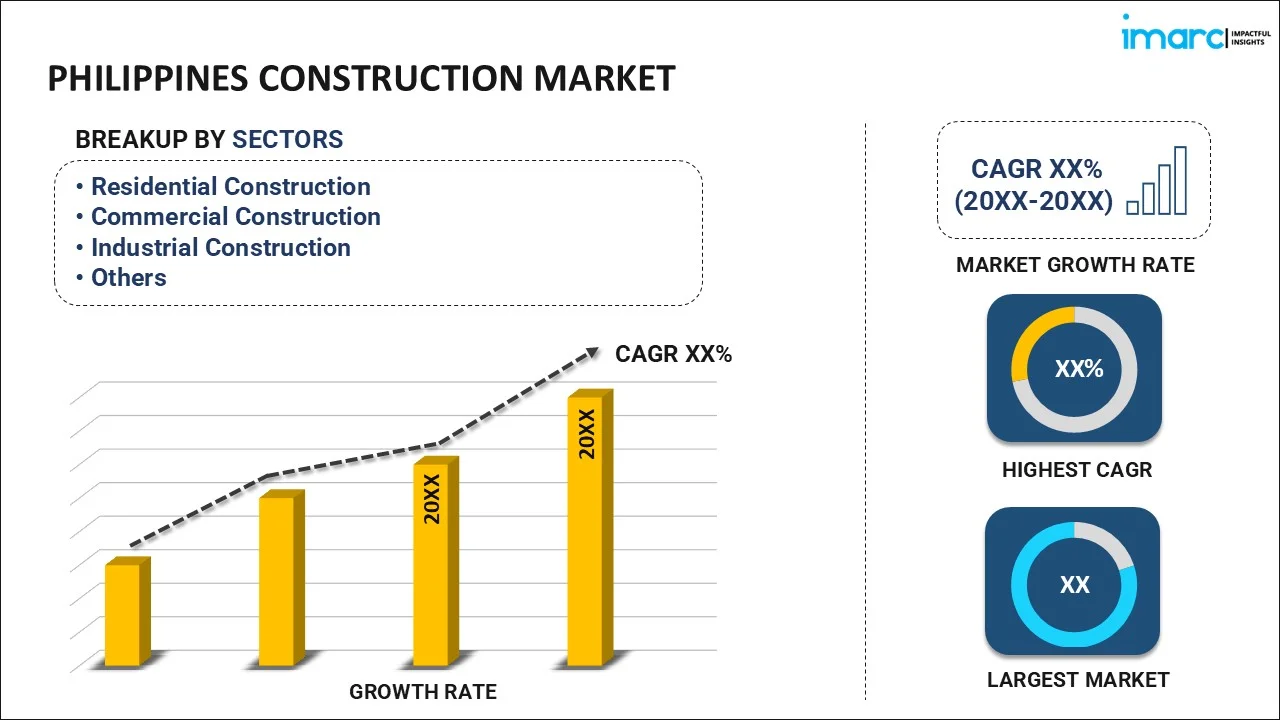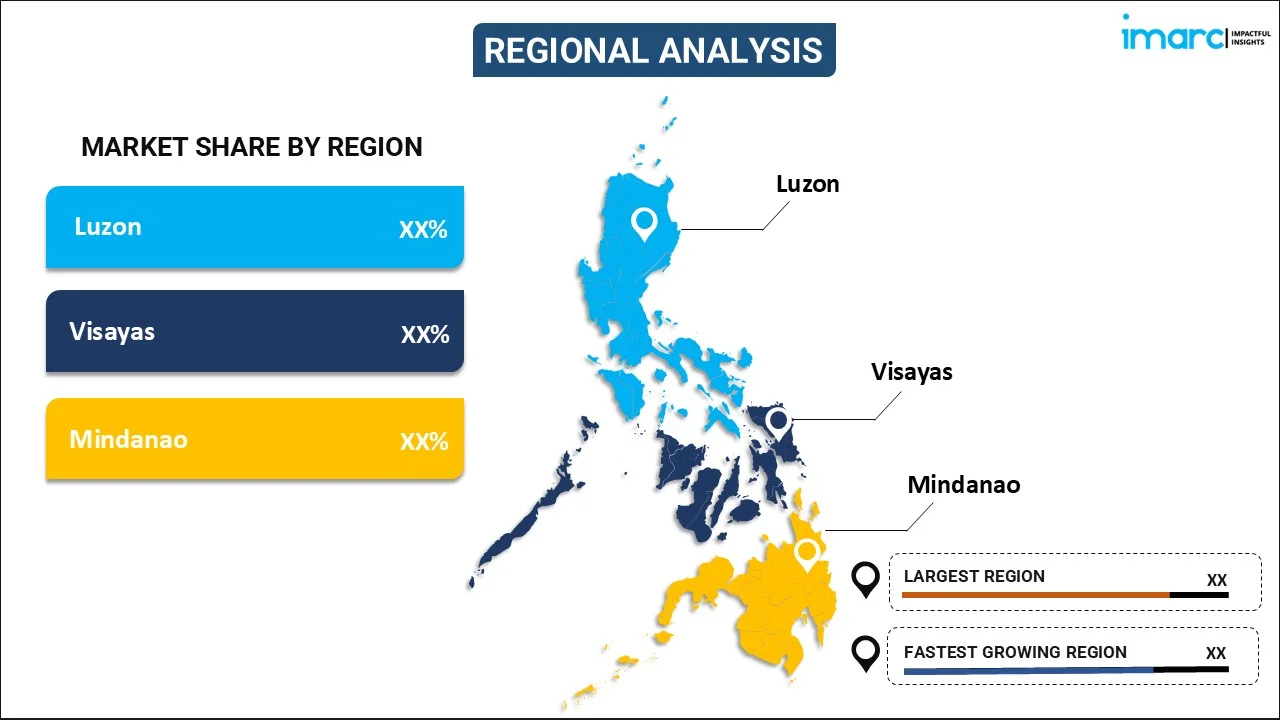
Philippines Construction Market Size, Share, Trends and Forecast by Sector and Region, 2025-2033
Philippines Construction Market Overview:
The Philippines construction market size reached USD 39.40 Billion in 2024. Looking forward, IMARC Group expects the market to reach USD 60.08 Billion by 2033, exhibiting a growth rate (CAGR) of 4.80% during 2025-2033. The rising infrastructure investments, rapid urbanization, government-backed projects, growing foreign direct investments, increasing demand for residential and commercial spaces, expansion of transport networks, and technological advancements in construction methods are some of the factors positively impacting the Philippines construction market share.
|
Report Attribute
|
Key Statistics
|
|---|---|
|
Base Year
|
2024
|
|
Forecast Years
|
2025-2033
|
|
Historical Years
|
2019-2024
|
| Market Size in 2024 | USD 39.40 Billion |
| Market Forecast in 2033 | USD 60.08 Billion |
| Market Growth Rate 2025-2033 | 4.80% |
Philippines Construction Market Trends:
Government Infrastructure Initiatives
The market is driven by large-scale infrastructure programs aimed at improving connectivity and economic growth. The government-funded projects focus on transportation, water resources, energy, and digital infrastructure. The increased construction of road networks, rail systems, and airports facilitates the Philippines construction market growth. The construction of bypass roads enhances logistics efficiency, fostering industrial and commercial development. Public-private partnerships (PPPs) stimulate foreign investments in infrastructure development with modernized facilities and services. Smart city projects utilize digital solutions for effective urban planning and management. Also, infrastructure development initiatives extend opportunities for construction companies, suppliers of materials, and service providers, which creates employment opportunities and economic upliftment.
The government's commitment to infrastructure generation ensures that there will be an uninterrupted flow of projects into the construction sector. According to an industry report, the Philippine Public-Private Partnership (PPP) Center announced the roll-out of 173 infrastructure projects worth about USD 56 Billion, with transportation, health, and information technology as the main sectors. This initiative consists of 95 solicited projects with a value of USD 21 Billion and 78 unsolicited projects with a value of USD 37 Billion. In line with this, to increase the economic potential of the construction industry, the Society of Construction Law Philippines (SCLP) and the Department of Trade and Industry's Construction Industry Authority of the Philippines (DTI-CIAP) signed a MoU. The goals of this collaboration are to create standardized contract templates that cater to the demands of various stakeholders and to start awareness campaigns and training initiatives on construction rules and standard contract conditions.
Emphasis on Sustainable and Green Building Practices
The increasing environmental awareness and evolving industry standards are positively influencing the Philippines construction market outlook. Green building practices reduce energy consumption, waste, and consumption of resources. Developers have started using eco-friendly building materials-recycled concrete, bamboo, and low-carbon cement to minimize environmental impact. Smart building systems are being adopted widely, which include features such as light automation, ventilation control, and water management, thereby ensuring maximum energy use. Additionally, there is an increasing number of certification programs to ensure compliance with green building standards, which are connected to sustainable development. With the increasing demand for eco-friendly design in residential, commercial, and industrial projects, construction companies are compelled to innovate environmentally responsible growing solutions in line with international environmental objectives. On November 28, 2024, the Department of Trade and Industry's Construction Industry Authority of the Philippines (DTI-CIAP), in collaboration with the Philippine Constructors Association (PCA), convened the 5th Philippine Construction Congress to promote sustainable and innovative building practices. The program brought together industry leaders, stakeholders, and experts to discuss sustainable construction, regulatory innovation, and green construction trends.
Philippines Construction Market Segmentation:
IMARC Group provides an analysis of the key trends in each segment of the market, along with forecasts at the country level for 2025-2033. Our report has categorized the market based on sector.
Sector Insights:

- Residential Construction
- Commercial Construction
- Industrial Construction
- Infrastructure (Transportation) Construction
- Energy and Utilities Construction
The report has provided a detailed breakup and analysis of the market based on the sector. This includes residential construction, commercial construction, industrial construction, infrastructure (transportation) construction, and energy and utilities construction.
Regional Insights:

- Luzon
- Visayas
- Mindanao
The report has also provided a comprehensive analysis of all the major regional markets, which include Luzon, Visayas, and Mindanao.
Competitive Landscape:
The market research report has also provided a comprehensive analysis of the competitive landscape. Competitive analysis such as market structure, key player positioning, top winning strategies, competitive dashboard, and company evaluation quadrant has been covered in the report. Also, detailed profiles of all major companies have been provided.
Philippines Construction Market News:
- July 2024: The Philippine Domestic Construction Board (PDCB) conducted a 16-hour training course titled "Training Course on Understanding Construction Contracts," aimed at enhancing the expertise of academic professionals in the construction sector. This initiative reflects PDCB's commitment to advancing construction education and ensuring that educators are well-versed in contractual aspects of the industry.
- October 17, 2024: President Ferdinand Marcos Jr. led the groundbreaking ceremony of the MTerra Solar Project, recognized as the world's largest integrated solar and battery storage facility. The construction of this project, which is full swing, signifies a significant milestone in renewable energy development, highlighting the country's commitment to sustainable and clean energy solutions.
Philippines Construction Market Report Coverage:
| Report Features | Details |
|---|---|
| Base Year of the Analysis | 2024 |
| Historical Period | 2019-2024 |
| Forecast Period | 2025-2033 |
| Units | Billion USD |
| Scope of the Report |
Exploration of Historical Trends and Market Outlook, Industry Catalysts and Challenges, Segment-Wise Historical and Future Market Assessment:
|
| Sectors Covered | Residential Construction, Commercial Construction, Industrial Construction, Infrastructure (Transportation) Construction, Energy and Utilities Construction |
| Regions Covered | Luzon, Visayas, Mindanao |
| Customization Scope | 10% Free Customization |
| Post-Sale Analyst Support | 10-12 Weeks |
| Delivery Format | PDF and Excel through Email (We can also provide the editable version of the report in PPT/Word format on special request) |
Key Questions Answered in This Report:
- How has the Philippines construction market performed so far and how will it perform in the coming years?
- What is the breakup of the Philippines construction market on the basis of sector?
- What is the breakup of the Philippines construction market on the basis of region?
- What are the various stages in the value chain of the Philippines construction market?
- What are the key driving factors and challenges in the Philippines construction market?
- What is the structure of the Philippines construction market and who are the key players?
- What is the degree of competition in the Philippines construction market?
Key Benefits for Stakeholders:
- IMARC’s industry report offers a comprehensive quantitative analysis of various market segments, historical and current market trends, market forecasts, and dynamics of the Philippines construction market from 2019-2033.
- The research report provides the latest information on the market drivers, challenges, and opportunities in the Philippines construction market.
- Porter's five forces analysis assist stakeholders in assessing the impact of new entrants, competitive rivalry, supplier power, buyer power, and the threat of substitution. It helps stakeholders to analyze the level of competition within the Philippines construction industry and its attractiveness.
- Competitive landscape allows stakeholders to understand their competitive environment and provides an insight into the current positions of key players in the market.
Need more help?
- Speak to our experienced analysts for insights on the current market scenarios.
- Include additional segments and countries to customize the report as per your requirement.
- Gain an unparalleled competitive advantage in your domain by understanding how to utilize the report and positively impacting your operations and revenue.
- For further assistance, please connect with our analysts.
 Inquire Before Buying
Inquire Before Buying
 Speak to an Analyst
Speak to an Analyst
 Request Brochure
Request Brochure
 Request Customization
Request Customization




.webp)




.webp)












